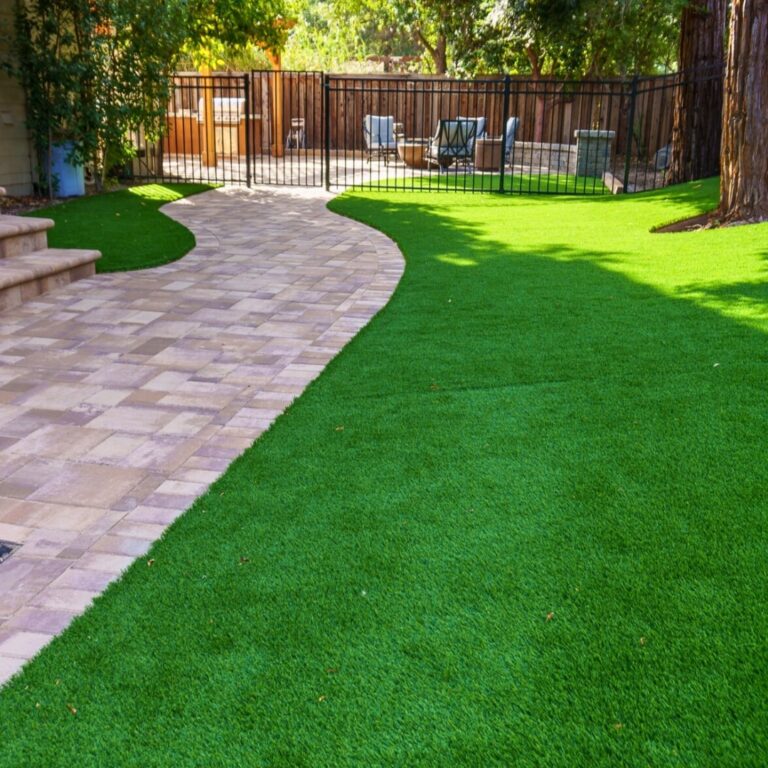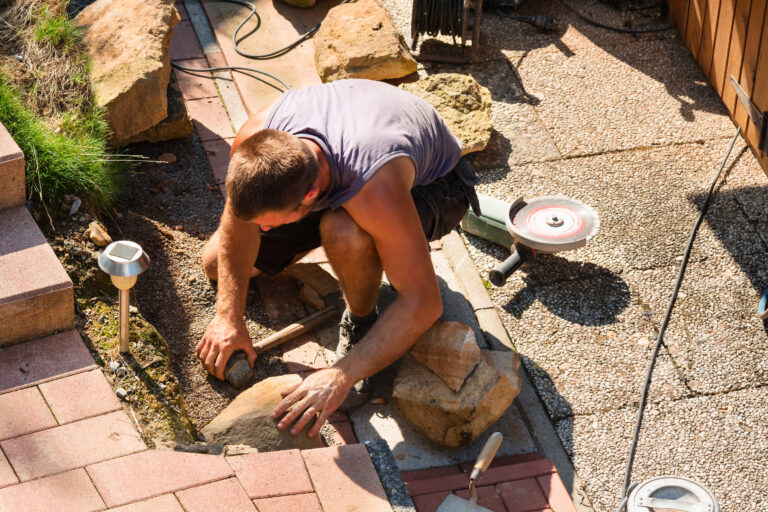How to Lay Pavers on Grass

Understanding how to lay pavers on grass is crucial for constructing recreational areas, gardens, or patios with safe paving. This type of flooring is durable and resistant, plus it comes in a variety of materials.
Read on to discover everything about installing pavers on grass and how they can be sustainable and economical.
Why Install Pavers on Grass?
Using pavers in outdoor areas, such as pool decks, is a great paving solution for lawn traffic.
Here are some benefits of using pavers on grass:
Benefits of Paving:
One of the advantages of using pavers on the lawn is increased safety and accessibility. It offers a stable surface that prevents accidents, such as driveway pavers
Another advantage is aesthetic enhancement, providing thermal comfort as it conserves the soil, preventing extreme cold or heat.
Interlocking pieces fit easily, requiring minimal maintenance. Moreover, pavers are an excellent choice for drainage flooring, improving water flow and bringing sustainability to the construction.
Types of Pavers
There are various types of pavers, made from different materials. See the purpose of each one below.
Concrete Pavers:
Made from a mix of cement and aggregates, they are molded and air-dried into various shapes. Given their durability, concrete pavers are an excellent paving option for high-traffic outdoor areas like sidewalks, patios, and pathways.
Advantages:
- More durable than poured concrete.
- Easy installation.
- Available in various shapes and colors.
Brick Pavers:
Made from natural clay, brick pavers are oven-baked, giving them a natural reddish color. They maintain their appearance for years.
Advantages:
- Variety of shapes and sizes.
- Retains original color for years.
- Highly durable.
Interlocking Pavers:
Designed like puzzle pieces, each piece has grooves and protrusions on its edges, allowing them to fit perfectly when installed following a pattern.
Advantages:
- Suitable for areas with intense traffic.
- Excellent for vehicle maneuvering.
- Ensures safe traffic for both cars and pedestrians.
Plastic Pavers:
Although not as durable as concrete and brick pavers, they are a cost-effective option. They can be made from recyclable materials, making them eco-friendly and ideal for garden lawns. However, they should have a non-slip finish and aren’t suitable for vehicular traffic.
Advantages:
- Available in various shapes, colors, and styles.
- Easy installation.
- Lower cost.
Essential Tools and Materials for Paver Installation
When installing pavers on the lawn, it’s essential to ensure that all necessary materials and tools are on hand for setting the pieces. Below, check out the list of essential materials for installing the pavers.
Basic Tools
Installing pavers requires tools like:
- Rubber mallet
- Level
- Tape measure
- mason’s gloves, etc.
Necessary Materials
To carry out the installation, the following materials are needed:
- Gravel
- Concrete or sand filler
- Polymeric sand,
- And the pavers.
Ground Preparation
To begin the installation of the pavers, it’s necessary to prepare the ground and the grass. Here’s how to do it:
Soil Alignment
It’s crucial to level the soil, ensuring pavers are well-aligned. Place a few blocks to check alignment against the project plan.
Compaction Techniques
Use a mixture of crushed stone, stone dust, and gravel. Compact the area to eliminate gaps, preventing sand wastage when placing the pavers.
Planting Grass
Spaces between pavers should be filled with sand where grass seedlings will be placed, then watered to settle.
Installation Techniques
For the installation of the pieces, it’s necessary to define a layout, which will be the planned paving design. Check out more details below.
Placement of the pieces
With a leveled base, arrange the pieces on the ground. You need to start with something that acts as a block, serving as a guide for containment.
A mason’s line will be crucial to maintain the leveling of the pavers. Continue fitting the blocks according to the layout design.
Popular paver layouts
Rectangular blocks and the so-called “little bricks” are the most well-known and used. Pavers are very versatile and easy to work with. The most common layouts are: running bond, herringbone, and basket weave.
Overcoming Common Challenges
There are some essential tips when installing pavers to prevent damage to the lawn. Check them out!
Handling Irregular Surfaces
First and foremost, it’s important that the surface receiving the paver installation is completely even. Alignment and compaction are essential.
Compaction is responsible for stabilizing the soil. It can be achieved using a mechanical or electric compactor.
Ensuring Proper Water Drainage
Use channels and drains to direct water flow. Using gravel creates a drainage layer, allowing water infiltration and soil absorption. It’s also vital to use sand or another suitable material for jointing, preventing water accumulation.
Preventing Weed Growth
To prevent weeds, keep the grass neatly trimmed.
Paver Maintenance and Care
Regular maintenance ensures pavers remain in top condition. Check for broken pieces and other issues.
Cleaning Recommendations
Sweep and wash to remove dirt. Trim the grass and remove weeds.
Sealing Pavers
Sealing keeps pavers in place and properly aligned. Always check joints and refill with sand if needed.
Safety Tips for Paver Maintenance
To ensure that the pavers on the lawn remain in perfect condition and provide a safe pavement, it is recommended to perform preventive maintenance.
To ensure that the pavers on the lawn remain in perfect condition and provide a safe pavement, it is recommended to perform preventive maintenance.
Included in the maintenance are:
- Surface cleaning;
- Debris removal;
- Unclogging of channels and drains;
- Addressing any damage to the flooring by replacing the piece.
Conclusion After understanding more about pavers on the lawn and their installation, it’s evident that it’s a type of pavement with many benefits and easy installation. Therefore, the tips on paver installation are crucial for a safe installation that ensures effective water drainage.
Included in the maintenance are:
- Surface cleaning;
- Debris removal;
- Unclogging of channels and drains;
- Addressing any damage to the flooring by replacing the piece.
Conclusion
After understanding more about pavers on the lawn and their installation, it’s evident that it’s a type of pavement with many benefits and easy installation. Therefore, the tips on paver installation are crucial for a safe installation that ensures effective water drainage.






